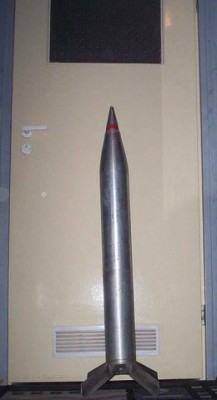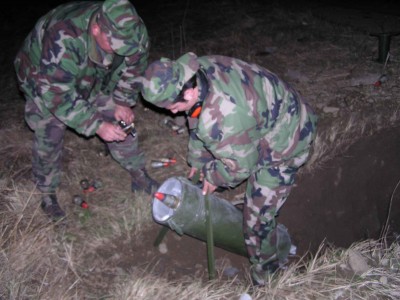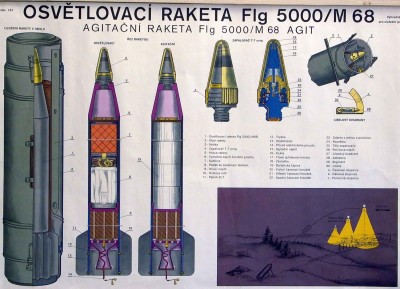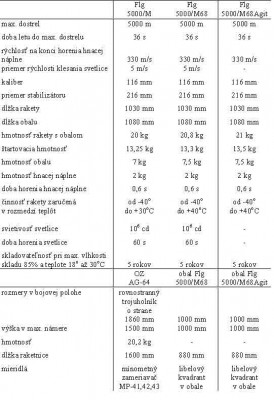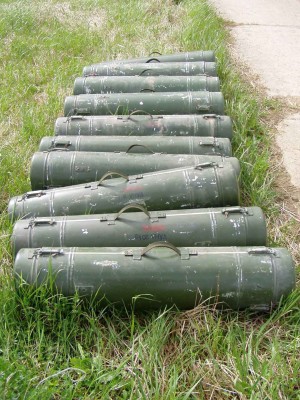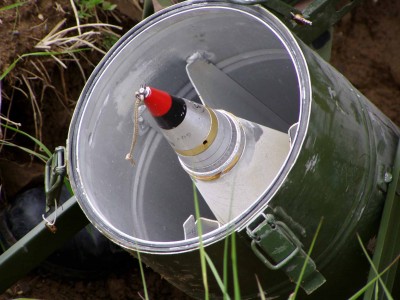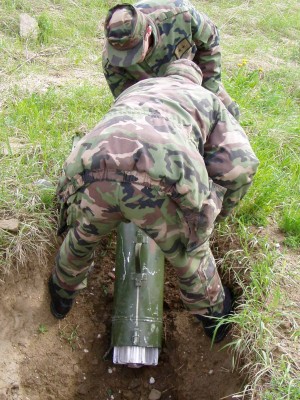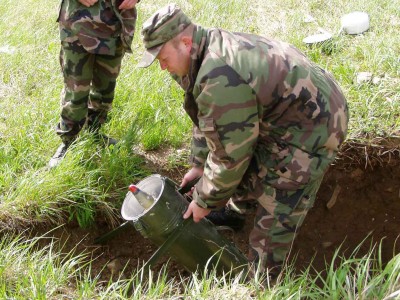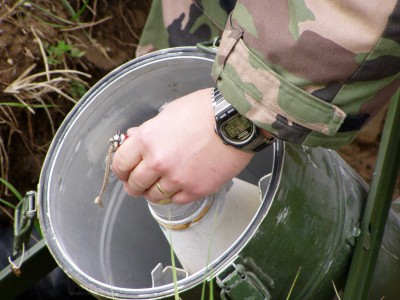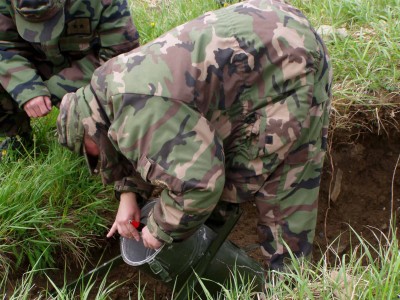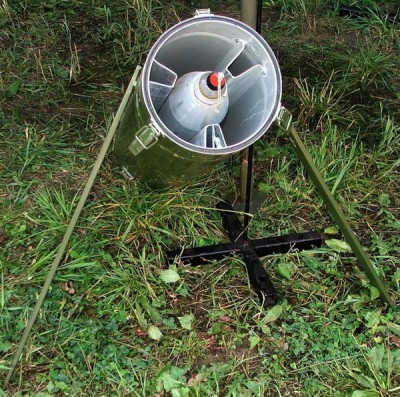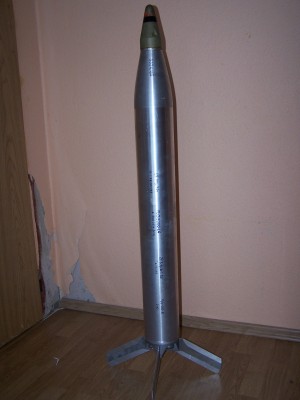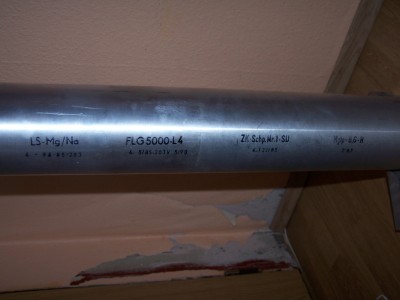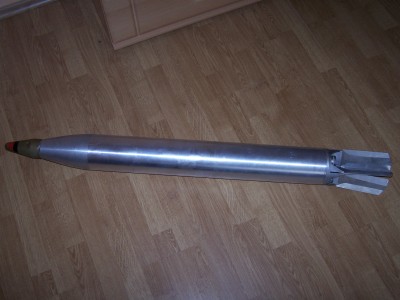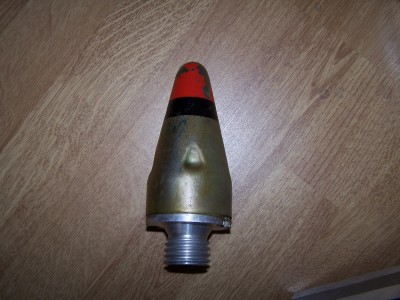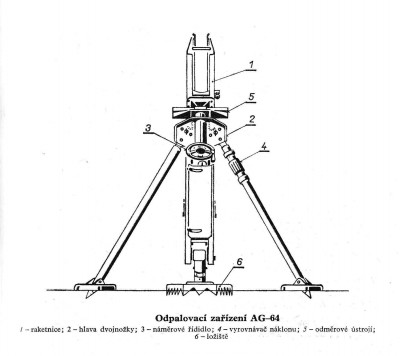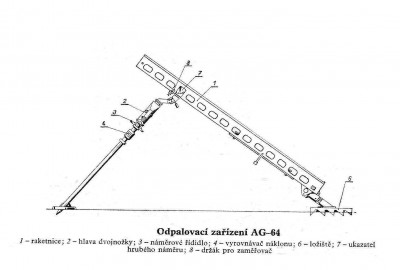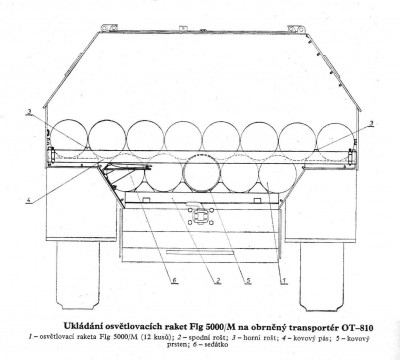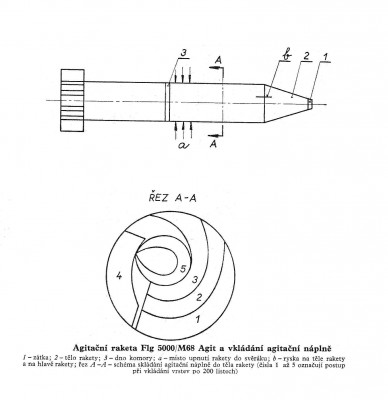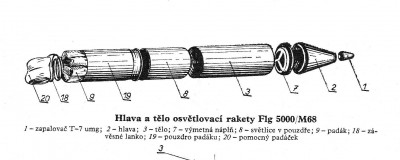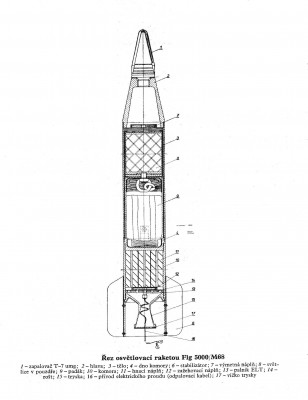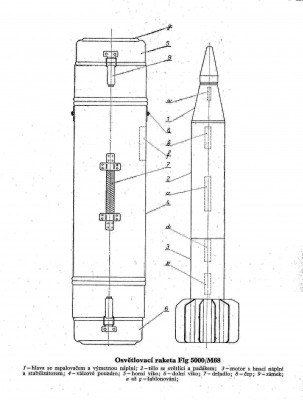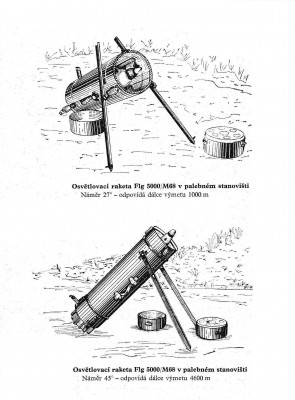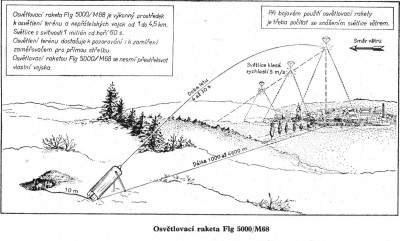LIGHTING RACKET Flg 5000/M 68 and Flg 5000/M
It is a powerful means of illuminating the terrain and enemy troops, at a distance of 1 - 4.5 km from the launch site. They are designed for combat use, when using Flg/M 68 safety regulations must be strictly observed. There is no significant difference between them.
- Flg 5000/M 68 is fired directly from the package
- Flg 5000/M is fired from the AG-64 launcher, only exceptionally can it be fired directly from the package
In all these cases, the lighting rocket fires el. detonator from the cover - you can use any el. sources with a voltage of at least 4 V, in which case the resistance of the line can be max. 2 ohms.
Lighting rocket FLG 5000/M68
The complete lighting agent consists of a specified amount of Flg 5000/M68 in the packaging and accessories.
Lighting rocket Flg 5000/M68 consists of:
- heads with lighter and projectile
- from a body with a flare and a parachute
- from the engine with the propellant charge and the stabilizer
Head with lighter and propellant cartridge
The conical head is equipped with a modified T-7 lighter/T-7 umg/and a projectile black dust cartridge. It is firmly screwed together with the rocket body.
Rocket body
The rocket body is a hollow cylinder provided with threads on both sides. The head is screwed into the front thread, the bottom of the chamber is screwed into the rear thread. Inside, there is a flare in a case and a folded parachute with a suspension cable.
Svetlica
The flare is a cylindrical body measuring 106 X 190 mm, pressed into an aluminum housing. It consists of three compression-assembled light compositions: a main light composition, an incendiary composition and a portable composition. The weight of all components together is about 2600 g. The light component consists of powdered magnesium and sodium disulfate. Fermez is used as a binder. On the upper side/on the side towards the engine/the case is provided with a support plate made of aluminum alloy, in which a steel eye pin for the parachute suspension cable is fixed.
Parachute
The parachute has an auxiliary parachute, which after sweeping the flare from the rocket body pulls the parachute case from the folded parachute and thus ensures its deployment.
Engine with stabilizer
The propellant consists of seven Dgtp 34x14/210 dust tubes weighing 2000 g. They are placed in a cylindrical chamber made of aluminum alloy on a steel grate. The chamber has a thread inside at both ends, on one side the bottom of the chamber made of aluminum alloy is screwed into it, on the other side a grate and a screwed steel nozzle are inserted. The openings of the grate are covered with aluminum foil.
The ELT 13 torch ignites the ignition charge and the propellant charge from it. The power supply is led through an opening in the nozzle cap and extended by a 10 m long firing cable. The firing cable is wound on cardboard placed next to the engine nozzle. The stabilizer has a ring screwed onto the outer thread of the nozzle. 6 pairs of wings are screwed to the ring (a total of 12 wings).
Operation of the FLG 5000/M68 lighting rocket
The electric current activates the burner, which ignites the ignition charge and the propellant charge ignites from it. The diaphragm (aluminum foil) on the grate ensures that the required pressure is reached and that the entire surface of the propellant is ignited evenly. The pressure of the gases inside the chamber rises very rapidly to about 15.7 MPa/160 kp/cm2/and hardly changes during the entire burning time of the propellant, ie about 0.6 s. The gases created by the combustion of the propellant rupture the foil on the grate, knock out the nozzle cap, flow through the nozzle and act on the rocket with a thrust of about 7,355 kN/750 kp /. This gives the rocket a speed that reaches 330 m/s at the end of combustion. The timing mechanism of the T-7 umg igniter is activated by the action of inertial forces during the accelerated movement of the rocket during the burning of the propellant. After burning the column of dust in the timing rings according to the set timing, the projectile charge is ignited. The pressure of the gases created by the combustion of the propellant charge separates the engine from other parts of the rocket.The flare ignited by the burning of the projectile is pushed out of the body of the rocket, even with a parachute, and is carried freely on the parachute to the ground. The burning flare descends at a speed of about 5 m/s and is carried by the wind. The head with the empty body and the engine with the burned-out propellant charge fall to the ground in a free fall. Therefore, it is forbidden to fire one's own troops with a light rocket, unless it is necessary due to the combat situation.
FLG 5000/M68 rocket packaging
Flg 5000/M68 lighting rockets are packed one by one in cylindrical aluminum packages modified so that the lighting rockets can be fired directly from the package. The case has a cylindrical case, two lids and legs.
Inside the cylindrical housing are guide rails that extend between the wings of the stabilizer. On the outer surface of the cylindrical case there are three locks for fixing the lid and the handle. The cylindrical housing also has two pins on which the legs are mounted. Inside the housing at the upper end, there is a spot-welded spirit level quadrand. It consists of a base, a segment and a remote scale, and an arm with a spirit level. The body of the spirit level is coated with a phosphating substance, which must be illuminated before use. After illuminating the spirit level with an electric lamp (white light without a color filter), at a distance of 5 cm for at least 10 seconds, the body of the spirit level shall be lit for at least 60 seconds. There are two scales on the segment with divisions of two steps. The inner surface of the cylindrical case is painted with colored khaki and a white line is marked on it to facilitate aiming in the direction. In the upper and lower part, the white line is painted with a phosphorescent substance and after lighting at night it shines.
The cylindrical case is closed with two aluminum lids. The front/top/lid has a polystyrene foam insert to prevent axial play of the rocket in the package. The selection contains a combined timing key and a brief instruction manual for the Flg 5000/M68 with abbreviated firing tables.
The legs are made of aluminum sheet. They are equipped with a tip and heel. At the upper end, they have two holes through which they fit on the pins of the cylindrical housing. Depending on the required elevation, these pins are fitted with an upper or lower hole.
During transport and storage, the feet are inserted into the guide rails inside the package.
Template
The data is marked on the Flg 5000/M68 lighting rocket by stenciling:
On the head of the lighting rocket:
At the age of:
g/The marking on the lid contains the data b, c, d, e.
Accessories
Each team of Flg 5000/M68 lighting rockets is equipped with accessories to ensure the launch of the Flg 5000/M68 lighting rocket from the package. The detailed list of backup sets of tool parts and accessories lists separately the accessories for launching the Flg 5000/M68 lighting rocket or the Flg 5000/M68 Agit agitating rocket from the package and separately for launching the Flg 5000/M lighting rocket from the AG-64 launcher.
Lighting rocket FLG/M68 - school
It is marked with a red triangle on the lighter with the inscription "SCHOOL" on the body of the projectile.
Flg 5000/M68 - the school is a dummy without all the contents and pyrotechnic compositions, but it is possible to build timing on it, unlock a spare lighter and connect the power supply.
FLG 5000/M lighting rocket
The Flg 5000/M lighting rocket is an older version of the Flg 5000/M68 lighting rocket. The difference is in the shape of the stabilizer and the design of the parachute. The supply of electric current is also solved differently: it is led through the opening of the nozzle, in its mouth there is a folded short cable terminated with a plug. During storage and transport, the nozzle is closed by a screwed cap with a rubber seal. The cap has a socket inside for inserting a fork. This short-circuits the plug to eliminate any static charge. Before firing, unscrew the cap (using a timing wrench if necessary) and insert the plug into the AG-64 launcher socket.
However, the main and most significant difference between the two missiles is in the front package and this results in a different way of firing.
FLG 5000/M lighting rocket package
Flg 5000/M are packed one by one in aluminum containers.The package consists of a cylindrical case with a handle and two lids. Each lid is connected to a cylindrical case with three locked locks. The rocket is held in the case by a circular metal insert fixed by three wing nuts.
An AG-64 launcher is used to launch the Flg 5000/M. Detonation directly from the package is allowed only exceptionally, if required by the unavoidable combat situation, or it is difficult to set the necessary measurement and measurement, to ensure detonation with a improvised neckline.
Rocket Transportation
The Flg 5000/M and Flg 5000/M68 lighting rockets and the Flg 5000/M68 Agit agitating rocket are generally transported in the prescribed aluminum packaging.
It is forbidden to carry rockets with a punched or unlocked lighter.
1. The aluminum packaging must not be damaged during loading and unloading or during transport, only damage to the paint is permissible.
2. They shall be loaded on the vehicle in a maximum of four layers. The rockets are placed horizontally in the direction of travel, not across.
3. Rockets in packages that have fallen from a height of up to 0.5 m are generally capable of use. Rockets with a damaged lighter hood, with broken stabilizer wings will be returned to the warehouse.
Rocket storage FLG 5000/M68 A FLG 5000/M
In the warehouse, lighting rockets are stored in packaging:
(a) to the boundaries horizontally in four layers. The individual layers are placed directly on top of each other, i.e. they are not translated by laths. The outer packagings must be secured against slipping.
Using missiles FLG 5000/M68
a) Preparation of firing position:
Flg 5000/M68 rockets are fired directly from aluminum containers built on the ground. According to the given tasks, the commander determines the firing position and the main direction. The main direction is drawn either according to the map, landmarks in the terrain or according to the compass.
b) Preparation of the Flg 5000/M68 rocket for launch:
After opening the three locks, the lower lid is folded. The cover is rotated by 180 ° and after opening the three locks, the upper lid with the polystyrene insert is folded. The timing key is selected from the cutout in the insert.
Both feet stored in the package in the guide rails are selected.
The lighter hood is assembled by unscrewing it clockwise (left-hand thread). The command key is used to set the commanded timing. The charger inserts the timing key onto the T-7 umg lighter so that the mandrel connecting the upper and lower timing rings fits into the cutout in the key hole.
By turning the key clockwise, the timing rings are adjusted so that the scale interval corresponding to the commanded timing coincides with the red setting mark.
The commanded distance is set on any quadrant. Depending on whether the distance was commanded up to 3500 m (divisions 2, 3, 1) or 4000 m and more (divisions 4,5), the feet are placed on the pins of the package with lower or upper holes.
Focus
The package with the racket and attached legs is placed on the ground. There is a white line on the cylindrical case of the package to facilitate aiming in the direction. The feet are pressed into the ground, or the back part of the package is moved until the spirit level is level with the set distance.
Detonation with igniter
The firing cord unwinds but does not connect to the igniter. The lighter is unlocked by pulling the pin by the twine eye. The pulled pin is not discarded - for possible new use to secure the lighter if the rocket did not fire. The Flg 5000/M68 rocket cable is terminated with two hooks. Both hooks are connected to the terminal block and the terminal block cable is connected to the igniter on command. The meter attaches the crank to the igniter and rotates it until the bulb lights up. At the command of "Pal" to fire by pressing the button. The launched missile must be fired. Only exceptionally, if the combat situation requires it, can the pin be secured again. At the same time, pressure or impact on the pin protruding from the lighter head must be avoided. Then, when the split pin is inserted, the firing position can be canceled. The lighter is set to "UD", the hood is screwed on and the cover is closed with a lid. The missile secured in this way is safe to transport and can be reused. In case of failure, the firing is repeated 2 more times.If the firing still does not take place, wait 3 minutes, disconnect the cable from the igniter, secure the lighter, wind the firing cable and insert it to the nozzle of the rocket engine. The failed missile thus secured is again safe to transport. When firing, the package is thrown backwards and is usually damaged. Therefore, the packaging is for single use only.
Using the FLG 5000/M rocket
a) Preparation of firing position:
If the rockets are ready for OT-810, it can be advantageously used as a cover for the operator.
The Flg 5000/M light rocket is launched from the AG-64 launcher. Only exceptionally, if required by the combat situation, it can be fired directly from the package, similar to Flg 5000/M68.
b) Launching Flg 5000/M from the package:
When firing it is necessary:
- unscrew the nozzle cover, remove the power supply and extend it with any cable at a distance of at least 10 m
- unscrew the three wing nuts and remove the round insert securing the projectile in the package
- set the rocket case in the direction (looking from the back through the lid handles
- set the measurement using any quadrant according to the firing tables. The package is supported by a fork, a mandrel or another means. If it is not possible to use a quadrant, the required aiming angle can be set using a 7.62 mm submachine gun vz. 58.
- Unclip the lighter and set the timing
- Detonate with a detonator.
Shooting in this way is especially accurate at longer distances than when firing from the AG-64. The empty package is thrown 8 to 10 m back after firing. c) Launching Flg 5000/M from the AG-64 launcher.
Preparation of the AG-64 launcher:
In the transport position, the launcher has its legs closed and the bipod and bearing are tilted to the rocket launcher.
At the designated place, the soil surface under the bearing is leveled, the bipod and the bearing are unfolded and the base is placed roughly in the main direction.
The cable is removed from the box on the rocket and unrolled towards the trench for the operator or to OT-810. The meter removes the crank from the igniter and still has it with it. The correctness of the firing circuit is tested.
The control bulb from the accessory is connected to the socket on the rocket launcher. The free end of the cable from the rocket launcher is connected to the rechargeable battery. The control lamp must be on. It is forbidden to use the igniter to test the circuit of the control bulb - the saq bulb will usually destroy it.
After testing the circuit, connect the end of the cable from the rocket to the igniter terminals. A sight is attached to the rocket launcher and a lighting device is connected as required.
Rocket preparation
Flg 5000/M rockets in packages are leveled on a pile 20 m to the left of the launcher. The charger still has a timer key with it. Unscrew the caps from the nozzles (counterclockwise) and the hoods from the lighters (clockwise). The stabilizer is overlooked. Rockets with damaged or missing wings must not be fired. The charger prepares the missiles and sets the commanded timing. The timed rocket is placed on the rocket launcher so that the racket rails lie between the wings where the stabilizing screws of the stabilizer wings are not. The cable is pulled out of the nozzle and its plug is inserted into the socket on the rocket launcher. Use the timing key (or combination pliers) to pull out the locking pin of the pin protruding from the lighter head. The split pin is not thrown in case the lighter is secured. The firing is performed by the igniter by connecting the cable from the AG-64 firing device to the igniter.
The safety provisions are the same as for the Flg 5000/M68. The Flg 5000/M lighting rocket must not be fired at air temperatures above + 30 ° C.
It is a powerful means of illuminating the terrain and enemy troops, at a distance of 1 - 4.5 km from the launch site. They are designed for combat use, when using Flg/M 68 safety regulations must be strictly observed. There is no significant difference between them.
- Flg 5000/M 68 is fired directly from the package
- Flg 5000/M is fired from the AG-64 launcher, only exceptionally can it be fired directly from the package
In all these cases, the lighting rocket fires el. detonator from the cover - you can use any el. sources with a voltage of at least 4 V, in which case the resistance of the line can be max. 2 ohms.
Lighting rocket FLG 5000/M68
The complete lighting agent consists of a specified amount of Flg 5000/M68 in the packaging and accessories.
Lighting rocket Flg 5000/M68 consists of:
- heads with lighter and projectile
- from a body with a flare and a parachute
- from the engine with the propellant charge and the stabilizer
Head with lighter and propellant cartridge
The conical head is equipped with a modified T-7 lighter/T-7 umg/and a projectile black dust cartridge. It is firmly screwed together with the rocket body.
Rocket body
The rocket body is a hollow cylinder provided with threads on both sides. The head is screwed into the front thread, the bottom of the chamber is screwed into the rear thread. Inside, there is a flare in a case and a folded parachute with a suspension cable.
Svetlica
The flare is a cylindrical body measuring 106 X 190 mm, pressed into an aluminum housing. It consists of three compression-assembled light compositions: a main light composition, an incendiary composition and a portable composition. The weight of all components together is about 2600 g. The light component consists of powdered magnesium and sodium disulfate. Fermez is used as a binder. On the upper side/on the side towards the engine/the case is provided with a support plate made of aluminum alloy, in which a steel eye pin for the parachute suspension cable is fixed.
Parachute
The parachute has an auxiliary parachute, which after sweeping the flare from the rocket body pulls the parachute case from the folded parachute and thus ensures its deployment.
Engine with stabilizer
The propellant consists of seven Dgtp 34x14/210 dust tubes weighing 2000 g. They are placed in a cylindrical chamber made of aluminum alloy on a steel grate. The chamber has a thread inside at both ends, on one side the bottom of the chamber made of aluminum alloy is screwed into it, on the other side a grate and a screwed steel nozzle are inserted. The openings of the grate are covered with aluminum foil.
The ELT 13 torch ignites the ignition charge and the propellant charge from it. The power supply is led through an opening in the nozzle cap and extended by a 10 m long firing cable. The firing cable is wound on cardboard placed next to the engine nozzle. The stabilizer has a ring screwed onto the outer thread of the nozzle. 6 pairs of wings are screwed to the ring (a total of 12 wings).
Operation of the FLG 5000/M68 lighting rocket
The electric current activates the burner, which ignites the ignition charge and the propellant charge ignites from it. The diaphragm (aluminum foil) on the grate ensures that the required pressure is reached and that the entire surface of the propellant is ignited evenly. The pressure of the gases inside the chamber rises very rapidly to about 15.7 MPa/160 kp/cm2/and hardly changes during the entire burning time of the propellant, ie about 0.6 s. The gases created by the combustion of the propellant rupture the foil on the grate, knock out the nozzle cap, flow through the nozzle and act on the rocket with a thrust of about 7,355 kN/750 kp /. This gives the rocket a speed that reaches 330 m/s at the end of combustion. The timing mechanism of the T-7 umg igniter is activated by the action of inertial forces during the accelerated movement of the rocket during the burning of the propellant. After burning the column of dust in the timing rings according to the set timing, the projectile charge is ignited. The pressure of the gases created by the combustion of the propellant charge separates the engine from other parts of the rocket.The flare ignited by the burning of the projectile is pushed out of the body of the rocket, even with a parachute, and is carried freely on the parachute to the ground. The burning flare descends at a speed of about 5 m/s and is carried by the wind. The head with the empty body and the engine with the burned-out propellant charge fall to the ground in a free fall. Therefore, it is forbidden to fire one's own troops with a light rocket, unless it is necessary due to the combat situation.
FLG 5000/M68 rocket packaging
Flg 5000/M68 lighting rockets are packed one by one in cylindrical aluminum packages modified so that the lighting rockets can be fired directly from the package. The case has a cylindrical case, two lids and legs.
Inside the cylindrical housing are guide rails that extend between the wings of the stabilizer. On the outer surface of the cylindrical case there are three locks for fixing the lid and the handle. The cylindrical housing also has two pins on which the legs are mounted. Inside the housing at the upper end, there is a spot-welded spirit level quadrand. It consists of a base, a segment and a remote scale, and an arm with a spirit level. The body of the spirit level is coated with a phosphating substance, which must be illuminated before use. After illuminating the spirit level with an electric lamp (white light without a color filter), at a distance of 5 cm for at least 10 seconds, the body of the spirit level shall be lit for at least 60 seconds. There are two scales on the segment with divisions of two steps. The inner surface of the cylindrical case is painted with colored khaki and a white line is marked on it to facilitate aiming in the direction. In the upper and lower part, the white line is painted with a phosphorescent substance and after lighting at night it shines.
The cylindrical case is closed with two aluminum lids. The front/top/lid has a polystyrene foam insert to prevent axial play of the rocket in the package. The selection contains a combined timing key and a brief instruction manual for the Flg 5000/M68 with abbreviated firing tables.
The legs are made of aluminum sheet. They are equipped with a tip and heel. At the upper end, they have two holes through which they fit on the pins of the cylindrical housing. Depending on the required elevation, these pins are fitted with an upper or lower hole.
During transport and storage, the feet are inserted into the guide rails inside the package.
Template
The data is marked on the Flg 5000/M68 lighting rocket by stenciling:
On the head of the lighting rocket:
At the age of:
g/The marking on the lid contains the data b, c, d, e.
Accessories
Each team of Flg 5000/M68 lighting rockets is equipped with accessories to ensure the launch of the Flg 5000/M68 lighting rocket from the package. The detailed list of backup sets of tool parts and accessories lists separately the accessories for launching the Flg 5000/M68 lighting rocket or the Flg 5000/M68 Agit agitating rocket from the package and separately for launching the Flg 5000/M lighting rocket from the AG-64 launcher.
Lighting rocket FLG/M68 - school
It is marked with a red triangle on the lighter with the inscription "SCHOOL" on the body of the projectile.
Flg 5000/M68 - the school is a dummy without all the contents and pyrotechnic compositions, but it is possible to build timing on it, unlock a spare lighter and connect the power supply.
FLG 5000/M lighting rocket
The Flg 5000/M lighting rocket is an older version of the Flg 5000/M68 lighting rocket. The difference is in the shape of the stabilizer and the design of the parachute. The supply of electric current is also solved differently: it is led through the opening of the nozzle, in its mouth there is a folded short cable terminated with a plug. During storage and transport, the nozzle is closed by a screwed cap with a rubber seal. The cap has a socket inside for inserting a fork. This short-circuits the plug to eliminate any static charge. Before firing, unscrew the cap (using a timing wrench if necessary) and insert the plug into the AG-64 launcher socket.
However, the main and most significant difference between the two missiles is in the front package and this results in a different way of firing.
FLG 5000/M lighting rocket package
Flg 5000/M are packed one by one in aluminum containers.The package consists of a cylindrical case with a handle and two lids. Each lid is connected to a cylindrical case with three locked locks. The rocket is held in the case by a circular metal insert fixed by three wing nuts.
An AG-64 launcher is used to launch the Flg 5000/M. Detonation directly from the package is allowed only exceptionally, if required by the unavoidable combat situation, or it is difficult to set the necessary measurement and measurement, to ensure detonation with a improvised neckline.
Rocket Transportation
The Flg 5000/M and Flg 5000/M68 lighting rockets and the Flg 5000/M68 Agit agitating rocket are generally transported in the prescribed aluminum packaging.
It is forbidden to carry rockets with a punched or unlocked lighter.
1. The aluminum packaging must not be damaged during loading and unloading or during transport, only damage to the paint is permissible.
2. They shall be loaded on the vehicle in a maximum of four layers. The rockets are placed horizontally in the direction of travel, not across.
3. Rockets in packages that have fallen from a height of up to 0.5 m are generally capable of use. Rockets with a damaged lighter hood, with broken stabilizer wings will be returned to the warehouse.
Rocket storage FLG 5000/M68 A FLG 5000/M
In the warehouse, lighting rockets are stored in packaging:
(a) to the boundaries horizontally in four layers. The individual layers are placed directly on top of each other, i.e. they are not translated by laths. The outer packagings must be secured against slipping.
Del 22-1
Using missiles FLG 5000/M68
a) Preparation of firing position:
Flg 5000/M68 rockets are fired directly from aluminum containers built on the ground. According to the given tasks, the commander determines the firing position and the main direction. The main direction is drawn either according to the map, landmarks in the terrain or according to the compass.
b) Preparation of the Flg 5000/M68 rocket for launch:
After opening the three locks, the lower lid is folded. The cover is rotated by 180 ° and after opening the three locks, the upper lid with the polystyrene insert is folded. The timing key is selected from the cutout in the insert.
Both feet stored in the package in the guide rails are selected.
The lighter hood is assembled by unscrewing it clockwise (left-hand thread). The command key is used to set the commanded timing. The charger inserts the timing key onto the T-7 umg lighter so that the mandrel connecting the upper and lower timing rings fits into the cutout in the key hole.
By turning the key clockwise, the timing rings are adjusted so that the scale interval corresponding to the commanded timing coincides with the red setting mark.
The commanded distance is set on any quadrant. Depending on whether the distance was commanded up to 3500 m (divisions 2, 3, 1) or 4000 m and more (divisions 4,5), the feet are placed on the pins of the package with lower or upper holes.
Focus
The package with the racket and attached legs is placed on the ground. There is a white line on the cylindrical case of the package to facilitate aiming in the direction. The feet are pressed into the ground, or the back part of the package is moved until the spirit level is level with the set distance.
Detonation with igniter
The firing cord unwinds but does not connect to the igniter. The lighter is unlocked by pulling the pin by the twine eye. The pulled pin is not discarded - for possible new use to secure the lighter if the rocket did not fire. The Flg 5000/M68 rocket cable is terminated with two hooks. Both hooks are connected to the terminal block and the terminal block cable is connected to the igniter on command. The meter attaches the crank to the igniter and rotates it until the bulb lights up. At the command of "Pal" to fire by pressing the button. The launched missile must be fired. Only exceptionally, if the combat situation requires it, can the pin be secured again. At the same time, pressure or impact on the pin protruding from the lighter head must be avoided. Then, when the split pin is inserted, the firing position can be canceled. The lighter is set to "UD", the hood is screwed on and the cover is closed with a lid. The missile secured in this way is safe to transport and can be reused. In case of failure, the firing is repeated 2 more times.If the firing still does not take place, wait 3 minutes, disconnect the cable from the igniter, secure the lighter, wind the firing cable and insert it to the nozzle of the rocket engine. The failed missile thus secured is again safe to transport. When firing, the package is thrown backwards and is usually damaged. Therefore, the packaging is for single use only.
Using the FLG 5000/M rocket
a) Preparation of firing position:
If the rockets are ready for OT-810, it can be advantageously used as a cover for the operator.
The Flg 5000/M light rocket is launched from the AG-64 launcher. Only exceptionally, if required by the combat situation, it can be fired directly from the package, similar to Flg 5000/M68.
b) Launching Flg 5000/M from the package:
When firing it is necessary:
- unscrew the nozzle cover, remove the power supply and extend it with any cable at a distance of at least 10 m
- unscrew the three wing nuts and remove the round insert securing the projectile in the package
- set the rocket case in the direction (looking from the back through the lid handles
- set the measurement using any quadrant according to the firing tables. The package is supported by a fork, a mandrel or another means. If it is not possible to use a quadrant, the required aiming angle can be set using a 7.62 mm submachine gun vz. 58.
- Unclip the lighter and set the timing
- Detonate with a detonator.
Shooting in this way is especially accurate at longer distances than when firing from the AG-64. The empty package is thrown 8 to 10 m back after firing. c) Launching Flg 5000/M from the AG-64 launcher.
Preparation of the AG-64 launcher:
In the transport position, the launcher has its legs closed and the bipod and bearing are tilted to the rocket launcher.
At the designated place, the soil surface under the bearing is leveled, the bipod and the bearing are unfolded and the base is placed roughly in the main direction.
The cable is removed from the box on the rocket and unrolled towards the trench for the operator or to OT-810. The meter removes the crank from the igniter and still has it with it. The correctness of the firing circuit is tested.
The control bulb from the accessory is connected to the socket on the rocket launcher. The free end of the cable from the rocket launcher is connected to the rechargeable battery. The control lamp must be on. It is forbidden to use the igniter to test the circuit of the control bulb - the saq bulb will usually destroy it.
After testing the circuit, connect the end of the cable from the rocket to the igniter terminals. A sight is attached to the rocket launcher and a lighting device is connected as required.
Rocket preparation
Flg 5000/M rockets in packages are leveled on a pile 20 m to the left of the launcher. The charger still has a timer key with it. Unscrew the caps from the nozzles (counterclockwise) and the hoods from the lighters (clockwise). The stabilizer is overlooked. Rockets with damaged or missing wings must not be fired. The charger prepares the missiles and sets the commanded timing. The timed rocket is placed on the rocket launcher so that the racket rails lie between the wings where the stabilizing screws of the stabilizer wings are not. The cable is pulled out of the nozzle and its plug is inserted into the socket on the rocket launcher. Use the timing key (or combination pliers) to pull out the locking pin of the pin protruding from the lighter head. The split pin is not thrown in case the lighter is secured. The firing is performed by the igniter by connecting the cable from the AG-64 firing device to the igniter.
The safety provisions are the same as for the Flg 5000/M68. The Flg 5000/M lighting rocket must not be fired at air temperatures above + 30 ° C.
